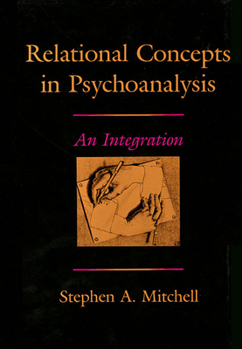Relational Concepts in Psychoanalysis: An Integration
Select Format
Select Condition 
Book Overview
There are more psychoanalytic theories today than anyone knows what to do with, and the heterogeneity and complexity of the entire body of psychoanalytic though have become staggering. In Relational Concepts in Psychoanalysis, Stephen A. Mitchell weaves strands from the principal relational-model traditions (interpersonal psychoanalysis, British school object-relations theories, self psychology, and existential psychoanalysis) into a comprehensive approach to many of the knottiest problems and controversies in theoretical and clinical psychoanalysis.
Mitchell's earlier book, Object Relations in Psychoanalytic Theory, co-authored with Jay Greenberg, set the stage for this current integration by providing a broad comparative analysis of important thinking on the nature of human relationships. In that classic study Greenberg and Mitchell distinguished between two basic paradigms: the drive model, in which relations with others are generated and shaped by the need for drive gratifications, and various relational models, in which relations themselves are taken as primary and irreducible. In Relational Concepts in Psychoanalysis, Mitchell argues that the drive model has since outlived its usefulness. The relational model, on the other hand, has been developed piecemeal by different authors who rarely acknowledge and explore the commonality of their assumptions or the rich complementarity of their perspectives. In this bold effort at integrative theorizing, Mitchell draws together major lines of relational-model traditions into a unified framework for psychoanalytic thought, more economical than the anachronistic drive model and more inclusive than any of the singular relational approaches to the core significance of sexuality, the impact of early experience, the relation of the past to the present, the interpenetration of illusion and actuality, the centrality of the will, the repetition of painful experience, the nature of analytic situation, and the process of analytic change. As such, his book will be required reading for psychoanalytic scholars, practitioners, candidates in psychoanalysis, and students in the field.Format:Hardcover
Language:English
ISBN:0674754115
ISBN13:9780674754119
Release Date:November 1988
Publisher:Harvard University Press
Length:340 Pages
Weight:1.40 lbs.
Dimensions:1.0" x 6.5" x 9.6"
Customer Reviews
4 ratings
Complicated concepts are easier to understand
Published by Thriftbooks.com User , 15 years ago
I appreciate Mitchell's ability to present psychoanalytic constructs and theories in an understandable manner. Make sure to read the introduction; it's a great review / introduction to this material.
a brilliant synthesis
Published by Thriftbooks.com User , 18 years ago
Stephen Mitchell was one of the original group of analysts who began to differentiate (along with Jay Greenberg) between drive/defense models of the self (e.g., Freud) and relational models. In this book Mitchell applies the relational perspective to several areas of clinical concern, including sexuality, childhood development, narcissism, and theories of change and healing. I recommend this book in the Theories of Depth Psychology graduate courses I teach; it is clear and refreshing and brings analytic thought a new and vitalizing emphasis on image, metaphor, story, and other aspects of the weave of relations we all remain in even when alone.
most influential book in psychoanalysis I've read
Published by Thriftbooks.com User , 20 years ago
I know people say this all the time, but I cannot recommend this book enough. As a developing clinician, this book has given me a tremendous advantage in conceptualizing cases. Mitchell draws on the best of the best in psychoanalysis and presents a very clear, convincing, and amazingly helpful integration.
Impressively clear and careful
Published by Thriftbooks.com User , 24 years ago
This book is one of the most clear, careful, and rigorous contemporary psychoanalytic theoretical texts around. Mitchell writes with the logic and incisiveness of an analytic philosopher or logician. Although one might wish his depictions of specific clinical examples were a bit more textured and colorful, the theoretical arguments here are some of the best and most clearly stated around. I hope that more contemporary psychoanalytic theorists will become able to achieve this level of theoretical clarity and rigor.






